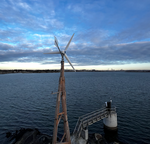05/27/2009
Netherlands - Taller wind turbine towers boost wind power generation
In the world of wind power, bigger turbines have been the trend for increased power generation, but a Netherlands based company believes that taller turbines may be the better way to go.
Usually hub heights for land based wind turbines are around the 100 meter mark. Advanced Tower Systems (ATS) claims an additional yield of 20 percent or more is possible by increasing tower heights, particularly in inland locations with lower wind speeds.
Obstructions from land forms, trees and buildings within an area can cause substantial wind intensity decreases and a buffeting effect with wind direction varying. While the breeze may feel strong, it also needs to be the right kind of breeze for a turbine to be its most effective. This buffeting effect provides even bigger challenges in built up areas, particularly for residential wind power systems in cities.
A system using the hybrid tower is installed at Germany’s Windtest test field at Grevenbroich, near Cologne and set to start working this week. The lower section of the tower is made of concrete pre-fabricated parts and the upper section of conventional steel A Siemens SWP 2.3 megawatt wind turbine with a 93 meter diameter rotor sits atop the tower. With its hub height of 133 meters, the system has an overall height of 180 meters.
According to ATS, the higher tower cost should be recouped in approximately four years and the maintenance costs are very low.
For more information please contact Trevor Sievert at ts@windfair.net
Usually hub heights for land based wind turbines are around the 100 meter mark. Advanced Tower Systems (ATS) claims an additional yield of 20 percent or more is possible by increasing tower heights, particularly in inland locations with lower wind speeds.
Obstructions from land forms, trees and buildings within an area can cause substantial wind intensity decreases and a buffeting effect with wind direction varying. While the breeze may feel strong, it also needs to be the right kind of breeze for a turbine to be its most effective. This buffeting effect provides even bigger challenges in built up areas, particularly for residential wind power systems in cities.
A system using the hybrid tower is installed at Germany’s Windtest test field at Grevenbroich, near Cologne and set to start working this week. The lower section of the tower is made of concrete pre-fabricated parts and the upper section of conventional steel A Siemens SWP 2.3 megawatt wind turbine with a 93 meter diameter rotor sits atop the tower. With its hub height of 133 meters, the system has an overall height of 180 meters.
According to ATS, the higher tower cost should be recouped in approximately four years and the maintenance costs are very low.
For more information please contact Trevor Sievert at ts@windfair.net
- Source:
- Online editorial www.windfair.net
- Author:
- Posted by Trevor Sievert, Online Editorial Journalist
- Email:
- ts@windfair.net
- Link:
- www.windfair.net/...
- Keywords:
- wind energy planning, wind energy, renewable energy, wind turbine, wind power, wind farm, rotorblade, onshore, offshore

























